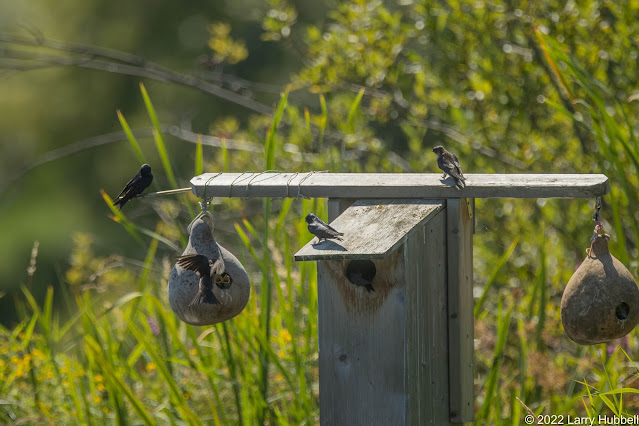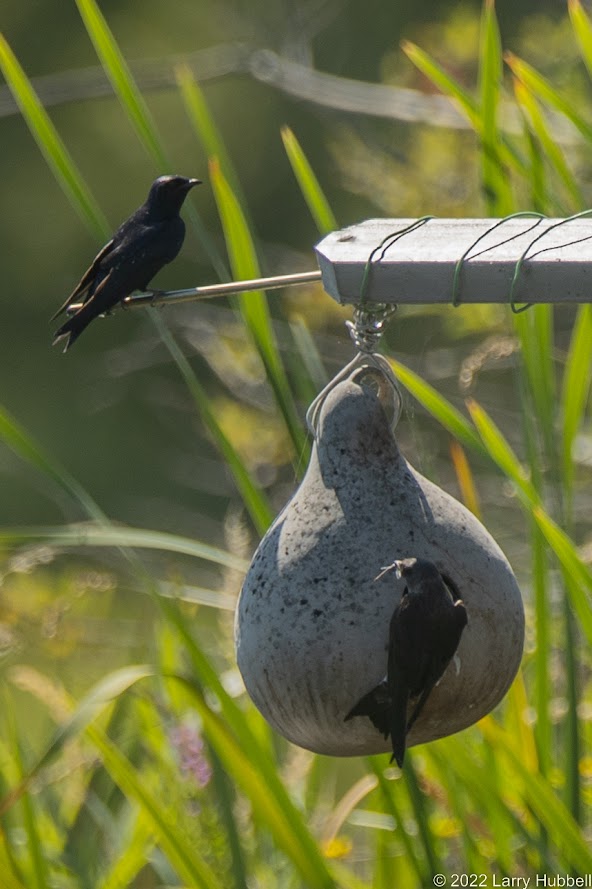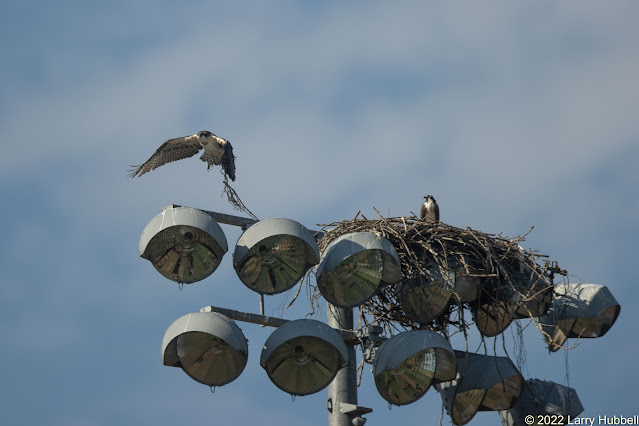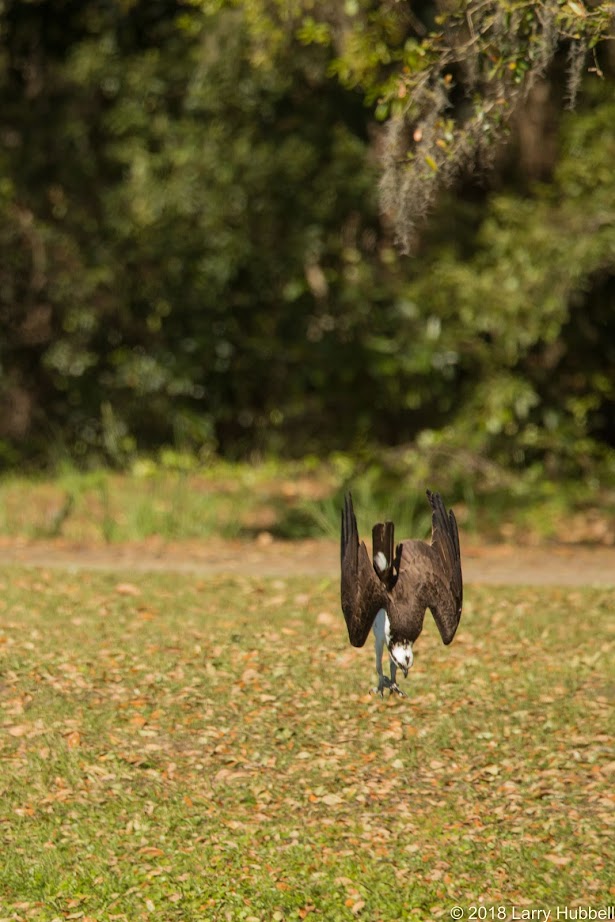To the casual observer, this might look like an adult Osprey carrying material to its nest. Sadly, that was not the case. This is a first-year bird, who just learned to fly, and should be focusing on finding its favorite food - Fish.
This story began last Tuesday, when Ronda, a very kind friend of our local Osprey sent me an email. She informed me that one of our two young Osprey (from the nest at the University of Washington Intramural Activities Field #3, south of the University Village, in Seattle) seemed to have her foot ensnared in a rope. I dropped everything and hurried over to try and help document the situation.
When the young bird left her sibling at the nest and headed toward her parents the rope became obvious.
There was even a stick tangled up in the mess. Briefly, I hoped that Tanya, short for Tanglefoot, was just holding the rope. My wishful thinking included her simply letting go. However, later when she stretched open her talons, before landing, the rope did not fall.
She labored through multiple flights, once when she landed directly in front of us, I caught an in-focus photo that showed the extent of the entanglement. The rope dangling from her lower left leg looked like a Gordian Knot gone wild.
When Tanya landed on our right, closer to her mother, we had a view of three-quarters of the family on a single light pole. By the way, female Ospreys are up to 20 percent larger than males. Both Tanya and her mother, Hope, certainly appear larger than her father, Stewart, on our left.
You may read more about some of the history of the Ospreys around Union Bay in these posts:
I visited the nest site the day before. All four of the Osprey, including Tanya and her sibling, were totally unencumbered at that point. The entanglement was a new development.
My best guess is one of the parents delivered the rope to the nest thinking it looked like good nesting material. It may have laid there undisturbed for weeks. Sometime during the day Tuesday, the young Osprey's foot must have become ensnared in the twisting mass.
As we watched, Tanya twisted and turned on top of the light pole. I suspect she was hoping to find a position without the weight pulling her down.
Notice how the dark feathers of the young Osprey are tipped in white, while her mother's dark feathers have no such markings. This is an obvious visual difference between a first-year Osprey and a mature adult.
Soon Tanya took off from the light pole and flew in circles above the field. For a moment, it felt reassuring that she could fly.
The day before while her sibling was coming and going from the nest Tanya watched closely. At that point, I do not think anyone had seen Tanya fly yet.
If I was Tanya, I would have been quite envious. Without obvious facial expressions, I have to wonder how much birds can communicate with their body language. Sometimes their behavior seems to imply obvious emotions.
It seemed incredibly ironic that on the day Tanya took her first flight she became entangled in a rope that might cause her demise.
The extra weight of the rope was obvious while watching how hard she had to pump her wings. I suspect the rope also reduced the joy of her first flight.

Nonetheless, it was still inspiring to see her in the air strong and healthy - until the thought of her future came like a dark cloud overshadowing the brilliant sunlight.
Ospreys are primarily fish eaters.
When stalking fish they hover high above the water They spot a target below and carefully time their dive. With the stick and rope hanging from her foot the weight would reduce the duration of her hunting and the tangled mass would make it virtually impossible to see a fish in the water below her. They typically dive straight down.
Even if she was able to successfully target a fish she would still be in trouble. Ospreys dive head first toward the water, they begin with their feet pointing upward. Just before hitting the water, they throw their feet in front of their face. I suspect this helps protect their face and sets them up to catch the fish. Even if nothing else went wrong, the rope and the stick would probably hit the water before she did and scare her fish away.
On the other hand, if she somehow hit the water before the rope, the odds of her successfully coming up with a fish while not getting tangled up and drowning seem rather small.

Initially, the parents may take pity on her and continue to feed her. However, their natural inclination is to begin to discontinue the feeding so that the young learn to hunt for themselves. Sometime, in the next month or so the adults will leave. It will be time for them to migrate south for the winter.
Typically, they leave the young behind, and when the urge to migrate grows strong enough the young head south on their own. Of course, by that point, the young are completely dependent on their own ability to catch fish.
Plus, the idea of someone with the approved credentials trying to remove the rope seems like a long shot too. As long as she is strong enough to fly, she will not let anyone get close to her. Once she becomes weak enough to be caught she will also be close to starving. On Tuesday afternoon, her prognosis did not look good.
However, around 8:30 on Tuesday evening Ronda reported the following. Her message began with a focus on Tanya's sibling.
"...She did not stay long, but flew full force over to the light pole where her sibling was perched as if to land almost on top of her. They locked talons and in the struggle that followed, the rope was pulled off of her sister's talons-- I think that is really what I saw! Both Osprey then flew free for some time before landing back on the nest."
Wow! I know of no way to prove that the sibling's help was intentional. However, during the many times I have watched Osprey I have never seen two of them grasp talons. At the very least, this time Tanya is the recipient of an incredibly positive coincidence.
On Thursday, I was lucky to find Tanya's sibling, Rima, perched above a nearby pool intently searching for fish.
Later, I found Tanya, free and unfettered, on a nearby snag. During the next few weeks, it will be wonderful to watch her fly free while developing the skills she will need during migration.
****************
In other news, Friends of Arboretum Creek (FOAC), has successfully completed the 30% Design phase of the Headwaters Project. This project will add clean water to Arboretum Creek, and enhance the ecosystem, while also protecting the Japanese Garden from flooding.
On Tuesday, we will be meeting just south of the Japanese Garden for a tour of the future work site. We will walk, talk and discuss the plans for reuniting Alder and Alley Springs with Arboretum Creek. This will include the planned piping, storm protection, water quality treatment, and potentially a small extension of Arboretum Creek.
Date: 8-16-22
Time: 6-7pm
Meet: Just south of Seattle's Japanese Garden
The FOAC website:
The 30% Design Report and Plans:
Current Activities:
****************
I hope this story makes it obvious that co-existing with nature in the city includes policing our trash, like an old knotted rope, and making sure it is unavailable to the wild creatures around us
Have a great day on Union Bay...where nature lives in the city!
Larry
Recommended Citation
Jackson, B. J. and J. A. Jackson (2020). Killdeer (Charadrius vociferus), version 1.0. In Birds of the World (A. F. Poole and F. B. Gill, Editors). Cornell Lab of Ornithology, Ithaca, NY, USA. https://doi.org/10.2173/bow.killde.01
Going Native:
Each of us, who breathe the air and drink the local water, needs to watch and protect our local environment. Native plants and trees encourage the largest diversity of lifeforms because of their long intertwined history with our local environment and native creatures. Even the microbes in the soil are native to each local landscape.
I hope we can inspire ourselves, our neighbors, and local businesses to respect native flora and support native wildlife at every opportunity. I have learned that our most logical approach to native trees and plants (in order of priority) should be to:
1) Learn and leave established native flora undisturbed.
2) Remove invasive species and then wait to see if native plants begin to grow without assistance. (When native plants start on their own, then these plants or trees are likely the most appropriate flora for the habitat.)
3) Scatter seeds from nearby native plants in a similar habitat.
4) If you feel you must add a new plant then select a native plant while considering how the plant fits with the specific habitat and understanding the plant's logical place in the normal succession of native plants.
***************
My friend Elaine Chuang shared several resources (that were new to me) from the January 2022 Washington Ornithological Society meeting. By the way, Elaine credits Vicki King for researching and supplying this information. The major new concept is that specific keystone native plants enable critical moths and caterpillars that in turn provide food for the great majority of birds, especially during the breeding season. Here are the top two links from her list.
Native Keystone Plants for Wildlife:
https://www.youtube.com/watch?v=O5cXccWx030
Resources for adding plants to your Pacific Northwest Garden:
https://wos.org/wos-wp/wp-content/uploads/2021/12/native-plant-resources-v2.pdf
***************
In the area below it is my intention to display at least one photo each week to help challenge us to know the difference between native and non-native lifeforms.
What is this plant? Is it native to our area?
Scroll down for the answer.
******************
Ocean Spray: Yes. It is native to the PNW. Click on the name to learn more. One of the interesting things about Ocean Spray is that as it dries out, in late August and early September, the flowers fade to an off-white and attract tiny bugs. In turn, these little creatures attract Bushtits i.e. the tiny gray-brown bird in the photo above.
*****************
The Email Challenge:
Over the years, I have had many readers tell me that Google is no longer sending them email announcements. As of 2021, Google has discontinued the service.
In response, I have set up my own email list. With each post, I will manually send out an announcement. If you would like to be added to my personal email list please send me an email requesting to be added. Something like:
Larry, I want to see more of nature. Please add me to your personal email list.
Thank you for your patience and interest!
My email address is:
LDHubbell@comcast.net
*******************
The Comment Challenge:
Another common issue is losing your input while attempting to leave a comment on this blog. Often everything functions fine, however, sometimes people are unable to make it past the robot-detection challenge or maybe it is the lack of a Google account. I am uncertain about the precise issue. Sadly, a person can lose their comment with no recovery recourse.
Bottom Line:
If you write a long comment, please, copy it before hitting enter. Then, if the comment function fails to record your information, you can send the comment directly to me using email.
My email address is:
LDHubbell@comcast.net
Sincerely,
Larry
*******************
A Final Photo:














































